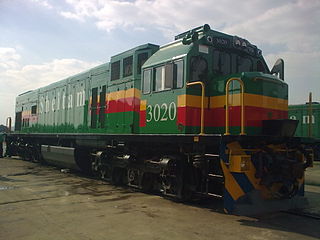
The Granville rail/train disaster occurred on Tuesday 18 January 1977 at Granville, a western suburb of Sydney, New South Wales, Australia, when a crowded commuter train derailed, running into the supports of a road bridge that collapsed onto two of the train's passenger carriages. The official enquiry found the primary cause of the crash to be poor fastening of the track.
The Vadodara train crash occurred on 21 April 2005 at the village of Samlaya near Vadodara in Gujarat when the Sabarmati Express passenger train crashed at high speed into a stationary goods train carrying cement.
The Gaisal train disaster occurred on 2 August 1999, when two trains carrying about 2,500 people collided at the remote station of Gaisal in West Bengal. Owing to a signalling error, both trains were using the same track on a day when three of the four tracks on the line were closed for maintenance. Their combined speeds were so great that the trains exploded on impact, killing at least 290 people.
The Igandu train disaster occurred during the early morning of June 24, 2002, in Tanzania. In one of the worst rail accidents in African history. A passenger train with over 1,200 people on board rolled backwards down a hill into a slow moving goods train, killing 281. The cause was brake failure, with unproven claims of sabotage.
There have been a number of train accidents on the railway network of Victoria, Australia. Some of these are listed below.
The railways of New South Wales, Australia have had many incidents and accidents since their formation in 1831. There are close to 1000 names associated with rail-related deaths in NSW on the walls of the Australian Railway Monument in Werris Creek. Those killed were all employees of various NSW railways. The details below include deaths of employees and the general public.

During the afternoon rush hour of June 22, 2009, a subway train wreck occurred between two southbound Red Line Washington Metro trains in Northeast, Washington, D.C., United States. A moving train collided with a train stopped ahead of it; the train operator along with eight passengers died, and 80 people were injured, making it the deadliest crash in the history of the Washington Metro.
The Marden rail crash occurred on 4 January 1969 near Marden, Kent, United Kingdom, when a passenger train ran into the rear of a parcels train, having passed two signals at danger. Four people were killed and 11 were injured. One person was awarded the British Empire Medal for his part in the aftermath of the collision.

The Hordorf train collision occurred on 29 January 2011, when a freight train and a passenger train collided near Hordorf in Saxony-Anhalt, Germany on the Magdeburg–Thale line. The passenger train derailed in the collision. Ten people were killed and 43 people were injured, some of them critically.
The Penukonda train collision occurred in the early hours of 22 May 2012, when the Bangalore bound Hampi Express crashed into a stationary freight train near Penukonda, in the Indian state of Andhra Pradesh. The incident killed 25 people while 43 people were injured. Three coaches derailed as a result of the crash while another caught fire. The fire was brought under control and rescue and relief operations started in a couple of hours. Railway Minister Mukul Roy, who was in Kolkata, rushed to the site of the accident and ordered an inquiry into it. Early reports suggested that Hampi Express overshot a signal and collided with a stationary goods train. Roy also announced a compensation of Rs 500,000 to the next of kin of the deceased, Rs 100,000 for those who sustained grievous injuries and Rs 50,000 to those who received minor injuries.

On 4 August 2015, two passenger trains – Kamayani Express and Janata Express – derailed near Kurawan and Bhringi railway station, 20 kilometres (12 mi) southwest of Harda, Madhya Pradesh. At least 31 people were killed and 100 people were injured.

The Hermalle-sous-Huy train collision was a collision between a passenger train and a freight train in Hermalle-sous-Huy, Belgium, on 5 June 2016. At least three people were killed and 36 others were injured, nine of them seriously.
The Andria–Corato train collision happened late in the morning of 12 July 2016 when two regional passenger trains on a single-track section of the Bari–Barletta railway collided head-on between the towns of Andria and Corato in the Apulia region of southern Italy. Twenty-three people were killed and 54 injured. The stretch of track is operated by regional rail company Ferrotramviaria.

On 4 January 2018, a passenger train operated by Shosholoza Meyl collided with a truck at a level crossing at Geneva Station between Hennenman and Kroonstad, in the Free State, South Africa. The train derailed, and seven of the twelve carriages caught fire. Twenty-one people were killed and 254 others were injured.
On 7 June 2021, before dawn, two trains collided near Daharki, in the Ghotki District of the southern province of Sindh in Pakistan, killing at least 65 people and injuring about 150 others. An express train derailed onto the opposite track, and a second express train crashed into the first roughly a minute later. About six to eight bogies were left "completely destroyed".